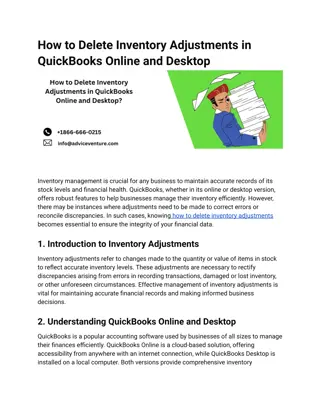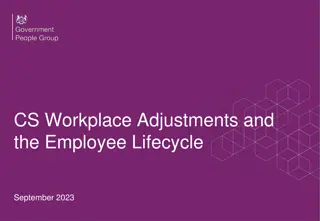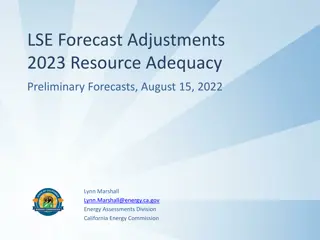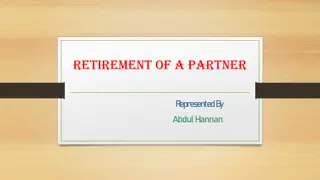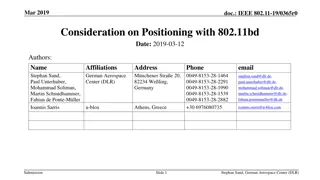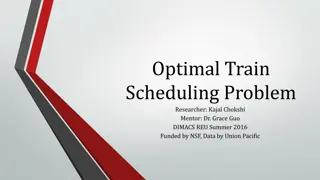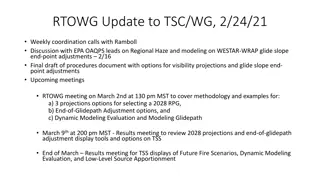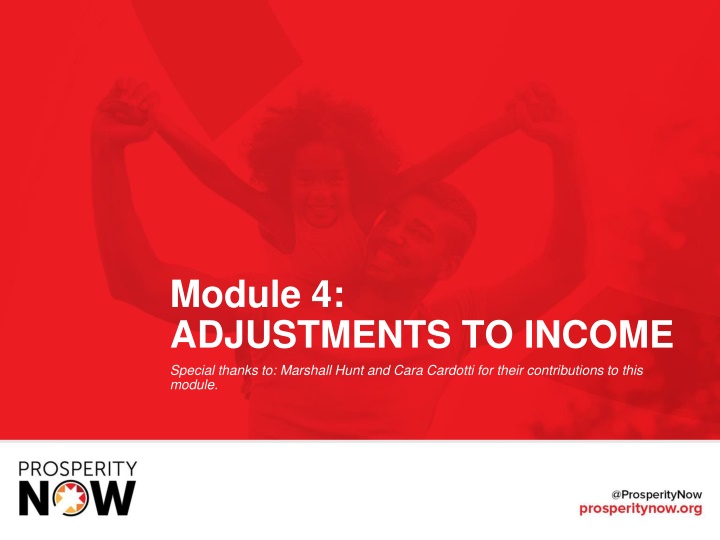
Adjustments to Income for Tax Purposes
Explore how Adjusted Gross Income impacts tax liability on Form 1040, including deductions such as Educator Expense, Alimony Paid, Student Loan Interest, and more. Learn how to calculate adjustments that lower taxable income and reduce income tax.
Download Presentation

Please find below an Image/Link to download the presentation.
The content on the website is provided AS IS for your information and personal use only. It may not be sold, licensed, or shared on other websites without obtaining consent from the author. If you encounter any issues during the download, it is possible that the publisher has removed the file from their server.
You are allowed to download the files provided on this website for personal or commercial use, subject to the condition that they are used lawfully. All files are the property of their respective owners.
The content on the website is provided AS IS for your information and personal use only. It may not be sold, licensed, or shared on other websites without obtaining consent from the author.
E N D
Presentation Transcript
Module 4: ADJUSTMENTS TO INCOME Special thanks to: Marshall Hunt and Cara Cardotti for their contributions to this module.
By the end of this module you will Understand how Adjusted Gross Income affects any tax liability/refund on the 1040 Understand and Calculate the Educator Expense Deduction Understand and Calculate the Penalty on Early Withdrawal of Savings Deduction Understand and Calculate the Alimony Paid Deduction Understand and Calculate the Student Loan Interest Deduction Understand the Self Employment Health Insurance Deduction Understand the HSA Deduction
In this module Adjusted Gross Income Educator Expense Deduction Penalty on Early Withdrawal of Savings Deduction Alimony Paid Deduction IRA Contributions Student Loan Interest Deduction Additional Adjustments Health Savings Accounts Deduction Self-Employment Tax Self-Employment Health Insurance Deduction
Adjusted Gross Income Understand how Adjusted Gross Income affects any tax liability/refund on the 1040
Adjusted Gross Income (AGI) Adjustments are deductions that decrease a taxpayer's gross income. Total Income Adjustments = Adjusted Gross Income (AGI) Any increases to adjustments will ultimately lower taxable income and reduce income tax. Note that adjustments do not lower other taxes, such as self-employment tax. . Adjustments are reported on Schedule 1, Part II and carried to Form 1040, Line 10.
Adjusted Gross Income (AGI) Adjustments to income lower your adjusted gross income dollar for dollar. Example: The taxpayer has $20,000 in Gross Income, $300 in educator expense deductions, $50 in penalty on early withdrawal of savings deductions, $2,000 in alimony paid deductions, and $1,000 in student loan interest deductions. What is the taxpayers AGI? Answer: Gross Income = $20,000. Total Adjustments to Income = $3,350 ($300 + $50 + $2,000 + $1,000) AGI = $16,650 ($20,000 - $3,350)
Educator Expense Deductions Understand and Calculate the Educator Expense Deductions
Educator Expense Deductions An eligible educator is allowed to deduct up to $300 (Single) or $600 (Married Filing Joint if both spouses are eligible educators) as Adjustments to Income An eligible educator is a kindergarten through 12thgrade teacher, instructor, counselor, principal, or aide in school for at least 900 hours during the school year Expenses must be qualified in order to take the Adjustments to Income. Qualified Expenses include: Ordinary and necessary expenses purchased, such as books, equipment, supplies, and other materials. Expenses do not have to be required in order to be considered necessary. Amounts paid or incurred for personal protective equipment, disinfectant, and other supplies used for the prevention of the spread of coronavirus. Additionally, professional development expenses are allowed unless reimbursement is offered by the school but not accepted. Professional development expenses include courses related to the curriculum in which the educator provides instruction. Excluded Expenses include: Homeschooling, Non-Athletic Supplies for courses in health or physical education
Educator Expense Deductions Qualified Expenses must be reduced by: The interest on Series EE and I U.S. savings bonds that you exclude from income because you paid qualified higher education expenses Any distribution from a qualified state tuition program that you exclude from income Any tax-free withdrawals from your Coverdell education savings accounts Any reimbursements you receive for expenses that aren't reported to you as wages on your W 2 Example: The taxpayer has $200 worth of qualified educator expenses. Throughout the school year, $50 was reimbursed for the art supplies the taxpayer needed to teach her class. What amount can the eligible educator include as an educator expense deduction? Answer: $150 ($200 - $50) is deductible as an Adjustment to Income on the taxpayer s Form 1040, Schedule 1, line 11.
Penalty on Early Withdrawal of Savings Deductions Understand and Calculate the Penalty on Early Withdrawal of Savings Deduction
Penalty on Early Withdrawal of Savings The taxpayer may have paid a penalty for an early withdrawal from their savings account (usually a certificate of deposit) This penalty can be identified on Form 1099-INT Box 2 or Form 1099 OID Box 2 The taxpayer will receive these forms from their bank Make sure to only deduct the amount on Box 2 of either Form 1099 INT or Form 1099 OID issued by the taxpayer s bank
Penalty on Early Withdrawal of Savings Example: The taxpayer says they have about $100 early withdrawal penalty from their bank. After asking them if they have their Form 1099-INT, they give you their paperwork. Box 2 lists $75. How much is deductible as an Adjustment to Income? Answer: $75 is deductible as an adjustment to income. Tax Preparers can only utilize the amount listed in Box 2 of Form 1099-INT or 1099-OID. The deduction is listed on Schedule 1, line 18. Note, the information from the bank may look more like a letter than a Form 1099-INT Whenever the taxpayer s documentation does not agree with what the taxpayer says, discuss the discrepancy with the taxpayer. Maybe he forgot to bring a second Form 1099-INT or other reasonable explanation. When in doubt, talk to the taxpayer!
Alimony Paid Deductions Understand and Calculate the Alimony Paid Deduction
Alimony Paid Deduction Alimony paid to a divorced spouse may be deductible as an Adjustment to Income that reduces AGI and included in the recipient spouse s income. A divorce before 1985 with alimony is out of scope. Note: Alimony will not be deductible for any divorce decree executed or modified after 2018. Alimony is not reported as income for the other party after December 31, 2018 Requirements for payments to be considered alimony paid: The ex-spouses do not file married filing jointly The payment was in cash (includes checks and money orders) The divorce does not designate the payment as not alimony The ex-spouses were not members of the same household when the payment was made The alimony payment was designated in a divorce/separation document and ordered by a judge There is no liability to continue alimony payments after the death of the spouse that receives the payment The payment is not treated as child support or a property settlement
Alimony Paid Deduction Alimony Paid is reported on the taxpayer s Schedule 1, line 19a. The taxpayer must also have the Social Security Number of ex-spouse they are making payments to. This is reported on the Schedule 1, line 19b. Report the date of the original divorce or separation agreement on Schedule 1, line 19c. Example: The taxpayer made alimony payments totaling $2,500 in the past year. They also made child support payments totaling $1,000 in the past year. How much can the taxpayer deduct as a For AGI deduction? Answer: $2,500. Child support payments are not considered For AGI deductions.
IRA Deduction Only contributions to traditional IRAs are deductible For 2024, the maximum combined traditional IRA deduction or Roth contribution is $7,000 .($8,000 if age 50 or older) Contributions cannot be more than taxpayer s yearly compensation The IRA deduction is listed on Schedule 1, line 20.
Student Loan Interest Deductions Understand and Calculate the Student Loan Interest Deduction
Student Loan Interest Deduction Interest on qualified student loans can be deducted up to $2,500 for the year in which the taxpayer paid interest A taxpayer must be legally liable for the loan. The taxpayer cannot be Married Filing Separate. Taxpayer or their Spouse cannot be claimed as dependents on someone else s return. Taxpayer may have a form from the lending institution or will be able to look up their account. The Student Loan Deduction is listed on Schedule 1, line 21.
Adjustments to Income These lines require an Advanced or other higher-level certification Line 12 certain business expenses of reservists, performance artists, and fee-basis governmental officials require Form 2106 Line 13 Health Savings Account (HSA) deductions use Form 8889. Line 14 Moving Expenses for members of the Armed Forces use Form 3903 requires military certification. Line 15 Self-Employment Tax Line 16 Self-employed SEP, SIMPLE, and qualified plans (out of scope) Line 17 self-employed health insurance deduction
Health Savings Account (HSA) An HSA is a medical savings account designed to pay for qualified medical expenses and save for future expenses on a tax-free basis. To be eligible to have an HSA, individuals must meet the following requirements: 1. Be covered by a high-deductible health plan 2. Not be covered by other insurance 3. Not be enrolled in Medicare 4. Not be eligible to be claimed as a dependent on another return A taxpayer has a family plan if their insurance covers themselves and a spouse or claimed dependent. A self-only plan covers only the taxpayer. Contributions to an HSA have an annual limit based on the type of plan. Self only plans: $4,150 or $5,150 for people age 55+ Family plans: $8,300 or $9,300 for people age 55+ Contributions can be made to an HSA up until the tax filing deadline, April 15, 2025.
HSA Contribution Deduction Taxpayers with an HSA may qualify for an adjustment to income for contributions to the account. Contributions made through a payroll deduction plan or by the taxpayer s employer do not qualify for the adjustment. These contributions will be shown on Form W-2 in box 12 with code W. Many taxpayers do not make contributions beyond payroll deductions or employer contributions and will not qualify for the adjustment. Use Form 8889 to collect information about a taxpayer s HSA contributions and figure the adjustment. Form 8889 also collects information about a taxpayer s HSA distributions. Distributions used for non- qualified medical expenses are taxable and subject to an additional 20% tax.
Self Employment Tax Deduction of self-employment tax can be deducted from income. Self-Employment tax is based on income reported on Schedule C and figured on Schedule SE. SE tax covers the Social Security and Medicare Tax for self-employed taxpayers. W-2 employees have half of their Social Security and Medicare Tax taken out of their paychecks automatically and the employer pays the other half. The self-employment Tax Deduction is listed on Schedule 1, line 15.
Self-Employed Health Insurance Deduction
Self-Employed Health Insurance Deduction Health insurance premiums paid by a self-employed taxpayer can be an adjustment to income The cost of all out-of-pocket, unreimbursed Medicare, supplemental, private and long-term care premiums paid for the taxpayer, spouse or dependent children can be used for the deduction If the taxpayer purchased a Marketplace plan and qualifies for the Premium Tax Credit the return is out of scope.
Self-Employed Health Insurance Deduction You can not deduct premiums for any month you were eligible for an employer subsidized health plan from your employer or your spouse's or child's employer You must show a net profit on schedule C The deduction is limited to the net profit minus the deductible part of the self-employment tax If the taxpayer is itemizing and meets the medical deduction threshold, do not allow any expenses entered as an adjustment to also be entered on schedule A
Knowledge Check - scenario Pat and Chris are married and wish to file a joint return. Pat and Chris are each 27 years old. They have no children. Pat teaches third grade at a private elementary school and spent 1,400 hours in the classroom during the tax year. Chris is a social service case manager for a nonprofit. Their combined income from work was $60,000, and they had $2,000 investment income from a certificate of deposit, which they cashed in six months early to pay for a new air conditioner for their home. Pat and Chris bring you the following expenses, which they hope to deduct: $600 classroom expenses for Pat. $2,300 student loan interest for Pat. $1,700 student loan interest for Chris. Chris is covered by a high deductible health plan (HDHP) at work all year. Chris' W-2 shows $1,200 in Box 12 with code W. Pat contributed $1,000 to a Roth IRA. $200 early withdrawal penalty for cashing in their certificate of deposit before its maturity date (they provide Form 1099-INT with $200 in Box 2).
Knowledge Check - question Pat and Chris bring you the following expenses, which they hope to deduct: $600 classroom expenses for Pat. $2,300 student loan interest for Pat. $1,700 student loan interest for Chris. Chris is covered by a high deductible health plan (HDHP) at work all year. Chris' W-2 shows $1,200 in Box 12 with code W. Pat contributed $1,000 to a Roth IRA. $200 early withdrawal penalty for cashing in their certificate of deposit before its maturity date (they provide Form 1099-INT with $200 in Box 2). Question: What is the total amount of adjustments that Pat and Chris can report on their tax return? A. $2,500 B. $3,000 C. $4,200 D. $7,000 Answer on the next slide.
Knowledge Check - answer Answer: B. $3,000 What they can claim: Pat is allowed to claim $300 in classroom expenses as an educator. Chris is not an educator, so $300 is the maximum educator expense deduction allowed. Pat and Chris can claim $2,500 student loan interest combined--not per person. Pat and Chris can claim the $200 early withdrawal penalty on their certificate of deposit. What they cannot claim: The excess classroom expenses and student loan interest amounts are not allowed. Code W in Box 12 of Form W-2 represents nondeductible HSA contributions, so the $1,200 HSA contribution is not allowed. Only traditional IRA contributions are eligible for the IRA deduction, so Pat's $1,000 contribution to a Roth IRA is not allowed.
Additional Resources Adjusted Gross Income: The IRS s definition of Adjusted Gross Income Educator Expense Deduction: IRS Topic No. 458 Penalty on Early Withdrawal of Savings: IRS and VITA Case Study Alimony Paid Deduction: IRS Topic No. 452 Student Loan Interest Deduction: IRS Topic No. 456 Publication 17 Up Next Module 5: Deductions


